Calculus Detection
Supragingival Calculus Deposits
Detect ABOVE the gingival margin
-
Visually with a good light source and dental mirror
-
Dry with compressed air to see rough, chalky appearance
Note: A wet surface reflects light, blending the calculus with the shiny tooth
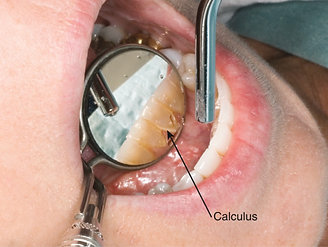
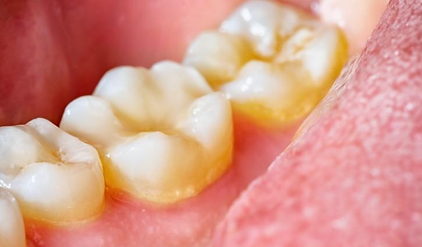
Subgingival Calculus Deposits
Detect UNDER the gingival margin within the gingival sulcus or periodontal pocket
-
Often flattened in shape due to the pressure of the pocket wall against the tooth
-
Residual = tiny remnants of a larger deposit remaining on the surface of the root after instrumentation
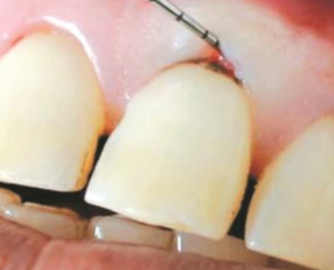
Common Calculus Formations

01
Spicule
-
An isolated, minute particle or speck of calculus.
-
Commonly found under contact areas, at line angles, and at the midline
02
Nodule
-
Larger spicule-type formations with a crusty or spiny surface
03
Ledge
-
A long ridge of calculus running parallel to the gingival margin.
-
Common on all tooth surfaces.
04
Ring
-
A ridge of calculus running parallel to the gingival margin that encircles the tooth.
05
Veneer
-
A thin, smooth coating of calculus with a "shield-like shape" located on a portion of the root surface.
06
Finger-like Formation
-
A long, narrow deposit running parallel or oblique to the long axis of the root.
Subgingival Conditions
Normal Conditions
The fingers do not feel any interruptions in the path of the explorer as it moves from the junctional epithelium to the gingival margin.

Ledge of
Subgingival Calculus
As the explorer tip moves along the tooth surface, it moves out and around the raised bump, and returns back to the tooth surface.
-
You will feel the tip move out and around the raised bump and return back to the tooth surface.
-
“Skating over a speed bump in a parking lot”
-
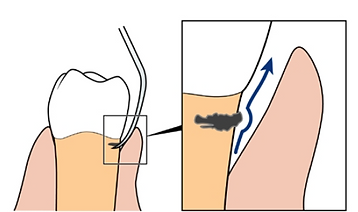
Restoration with
Deficient Margin
Explorer passes over the surface of the tooth and then dips in to trace the surface of the restoration.
-
This is similar to encountering the edge of a section of pavement that is lower than the surrounding pavement.
-
Your skates must move down onto this section of pavement.
-
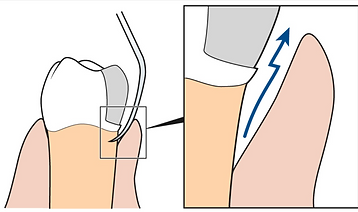
Spicules of
Subgingival Calculus
The explorer tip transmits a gritty sensation to the clinician's fingers as it passes over fine, granular deposits.
-
You will feel a gritty sensation as the explorer passes over the small calculus deposit.
-
“Inline skating over a few pieces of gravel”
-
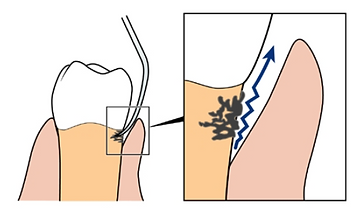
Restoration with Overhanging Margin.
The explorer's path is blocked by the overhang and must move away from the tooth surface and over the restoration.
-
This is similar to encountering the edge of a section of pavement that is higher than the surrounding pavement.
-
Your skates must move up and over the higher section of pavement.
-
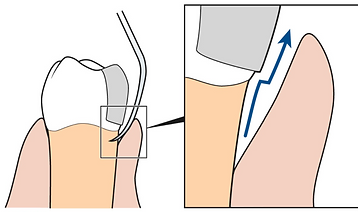
Subgingival Carious
Lesion (Decay)
The explorer dips in and then comes out again as it travels along the root surface.
-
This would be like skating into a pothole, across the pothole, and then back onto the pavement
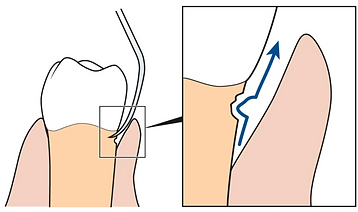
Causes of Undetected Calculus Deposits
-
Wrong explorer type or wrong side of the explorer used
-
Death grip: holding the explorer too tight
-
Middle finger
-
NOT on shank
-
applying TOO much pressure against shank
-
-
Strokes
-
are NOT overlapping
-
are INCORRECT at midlines of anteriors or line angles of posterior teeth
-
NOT extended apical (below) to contact area: not exploring half of surface from the facial or lingual aspect
-
-
FAILURE to
-
use compressed air
-
maintain constant adaptation to the tooth surface
-
roll handle to achieve adaptation when working around the line angle
-
insert explorer to the junctional epithelium before initiating the stroke
-
-
INCORRECT
-
patient head position
-
clinician clock position
-